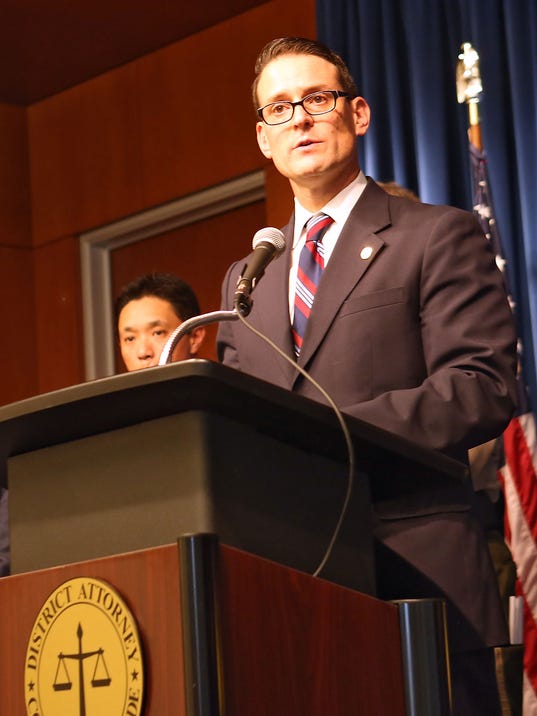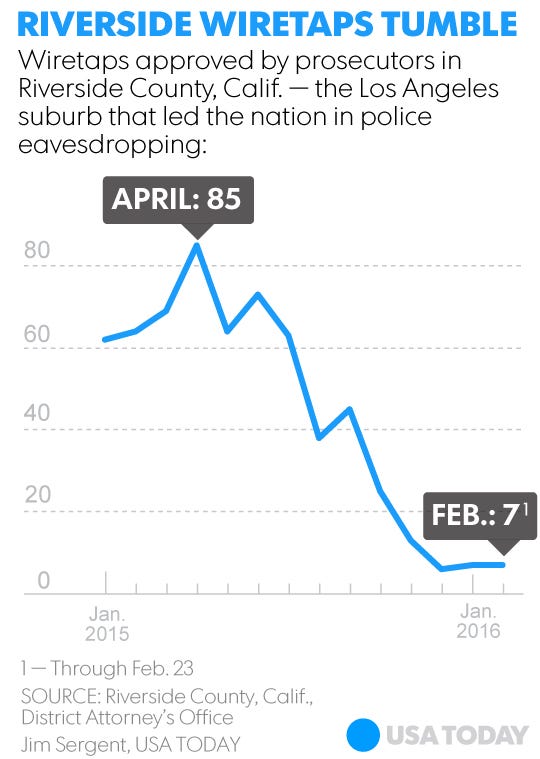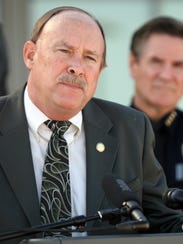Does this really surprise anyone? Isn't it just amazing what they can do if just one state judge signs a wiretap order?
<section id="module-position-O1b3Ckkgy8Q" class="storytopbar-bucket story-headline-module story-story-headline-module">
Prosecutors halt vast, likely illegal DEA wiretap operation
</section><section id="module-position-O1b3CkkhI94" class="storytopbar-bucket priority-asset-module story-priority-asset-module"></section>USA TODAY's Brad Heath discusses Riverside County, California wiretipes once nation's highest dropped considerably in 2015.
<section id="module-position-O1b3CwPSiI0" class="storymetadata-bucket expandable-photo-module story-expandable-photo-module"><aside itemprop="associatedMedia" itemscope="" itemtype="http://schema.org/ImageObject" class="single-photo expandable-collapsed">

(Photo: Jay Calderon, The (Palm Springs, Calif.) Desert Sun)
</aside></section>
33 COMMENTEMAIL
PALM SPRINGS, Calif. — Prosecutors in a Los Angeles suburb say they have dramatically scaled back a vast and legally questionable eavesdropping operation, built by federal drug agents, that once accounted for nearly a fifth of all U.S. wiretaps.
The wiretapping, authorized by prosecutors and a single state-court judge in Riverside County, alarmed privacy advocates and even some U.S. Justice Department lawyers, who warned that it was likely illegal. An investigation last year by The Desert Sun and USA TODAY found that the operation almost certainly violated federal wiretapping laws while using millions of secretly intercepted calls and texts to make hundreds of arrests nationwide.
Riverside’s district attorney, Mike Hestrin, acknowledged being concerned by the scope of that surveillance, and said he enacted “significant” reforms last summer to rein it in. Wiretap figures his office released this week offer the first evidence that the enormous eavesdropping program has wound down to more routine levels.
“I definitely don’t apologize for using this tool to hit the cartels in Riverside County,” said Hestrin, who took office last year. “I think the reforms I put in place were necessary, but this is still a tool that I believe in. It needs to be used cautiously, but it should be available when necessary.”
The number of wiretaps authorized in Riverside County started to climb in 2010; it quadrupled by 2014, when the county court approved 624 wiretaps — three times as many as any other state or federal court. Most of the surveillance was conducted at the behest of U.S. Drug Enforcement Administration agents, who used the eavesdropping to make arrests and seize drugs and cash as far away as New York and Virginia.
Officials approved another 607 wiretaps in 2015, according to the figures released by the district attorney’s office. Most were approved in the first half of the year, before Hestrin said he installed a “stricter” standard that required every new wiretap application to have a “strong investigatory nexus” to Riverside County.
Taps have dwindled since then. So far this year, Hestrin has approved only 14. In the first two months of last year, his office approved 126.

If the current rate continues, Riverside County will end 2016 with about between 85 and 120 wiretaps — still enough to rank it among the nation’s busiest wiretapping jurisdictions, based on 2014 records. But the county will no longer be in a stratosphere all its own.
“I’m pleased to hear this, but it never should have gotten out of hand in the first place,” said Steve Harmon, the Riverside County Public Defender. “If there is no strong investigative connection to Riverside County, then Riverside County has no interest being in this business.”
Privacy advocates, who had expressed alarm in the past, were more cautious.
Jennifer Lynch, a senior staff attorney with the Electronic Frontier Foundation, said it was “reassuring” the Riverside wiretap numbers had normalized, but worried there is “no oversight” even for new eavesdropping orders. Almost all wiretaps are sealed, and are sometimes kept secret even from the suspects who are arrested as a result of the eavesdropping, Lynch said.
“We are reliant on the prosecutors and the law enforcement officers to do their jobs and the judges not to just stamp a signature on them, but without releasing these on a regular basis it’s hard to be satisfied that the system is operating the way it should be,” Lynch said.
A Justice Department spokesman declined to comment on the abrupt drop in eavesdropping. In the past, DEA officials had said the surveillance was an important tool for targeting cartels that had turned the suburbs around Riverside into one of the nation's busiest drug trafficking corridors.
The majority of Riverside’s wiretap surge occurred under the watch of former District Attorney Paul Zellerbach, a one-term top prosecutor who was ousted by Hestrin at the end of 2014.
In interviews last fall, Zellerbach said his staff was “efficient and effective” at processing wiretaps. As word spread through law enforcement circles, the office received more and more requests to eavesdrop. Zellerbach had no qualms about leading the nation in taps. “I thought we were doing a hell of a job," Zellerbach said in November.
Others did not share that opinion. Justice Department lawyers warned the DEA in private that the wiretaps were unlikely to withstand a legal challenge, and they generally refused to use them as evidence in federal court.
<aside itemprop="associatedMedia" itemscope="" itemtype="http://schema.org/ImageObject" class="single-photo float">
 Former Riverside County, Calif., district attorney Paul Zellerbach presided over a sharp increase in wiretapping. (Photo: Crystal Chatham, The (Palm Springs, Calif.) Desert Sun)
Former Riverside County, Calif., district attorney Paul Zellerbach presided over a sharp increase in wiretapping. (Photo: Crystal Chatham, The (Palm Springs, Calif.) Desert Sun)
</aside>
The surveillance also suffered a more systematic flaw. The Desert Sun and USA TODAY found last year that Zellerbach had been allowing lower-level lawyers in his office to approve wiretap applications, despite a federal law that required him to do it himself. That flaw has the potential to invalidate as many as 738 wiretaps since 2013.
As a result, Riverside’s wiretap operation is now facing its first significant legal challenge. Lawyers for a marijuana trafficking suspect last week asked a federal judge in Kentucky to declare that five wiretaps used in that case were illegal. But their attack on the surveillance spoke far more broadly.
“In sum, Riverside County made a mockery of individual privacy rights, ignored federal requirements limiting the use of wiretaps and permitted law enforcement to intercept telephone calls at their whim and caprice,” argued attorney Brian Butler, a former federal prosecutor.
Although Zellerbach left the district attorney’s office at the end of 2014, the surge of eavesdropping continued well into 2015, with prosecutors approving hundreds in just the first few months of the year. Hestrin, the new district attorney, said most of those he approved were “spinoffs” of previous wiretaps, needed for investigations that he inherited from the Zellerbach administration. The volume was “staggering,” he said.
“A spinoff is technically a new wire but it’s from an existing investigation,” Hestrin said. “Maybe a bad guy is dropping one phone and getting a new one. And I wasn’t going to come in and shut down massive investigations into the cartel.”
Eventually, by the summer, the inherited investigations had run their course and Hestrin introduced his “new standard” for wiretap applications, limiting their use to cases in which the crime was closely tied to the county. In the past, court records show prosecutors had approved surveillance based on tenuous links to Riverside, including one case in which the DEA sought to use a Riverside wiretap to gather evidence on a money laundering suspect in Los Angeles on the basis that the phone belonging to a suspected courier had been in contact with a phone that had, in turn, been in touch with another phone belonging to a Riverside County nightclub owner.
After that change, Hestrin said law enforcement kept asking for wiretaps, but prosecutors “said no frequently.” Eventually, the requests stopped coming.
Riverside’s increased scrutiny of wiretaps applications is a step in the right direction, but it doesn’t erase years of taps that were awarded under questionable policies, said Adrienna Wong, an attorney for the American Civil Liberties Union of Southern California.
Wong said Wednesday that the ACLU submitted a public records request asking the DA’s office for wiretap polices — both old and new — after The Desert Sun/USA TODAY investigation was published.
The DA’s office refused.
“Given the lack of transparency, we remain concerned about the issue,” Wong said. “And the fact that the problem may be solved, at least for the time being … doesn’t address what may have happened in the past.”
Heath reported from McLean, Va. Kelman reports for The Desert Sun in Palm Springs, Calif.

This animation explains how phone tracker technology, commonly known as stingray, is used by the police. USA TODAY
Source:http://www.usatoday.com/story/news/2016/02/25/dea-riverside-wiretaps-scaled-back/80891460/
<section id="module-position-O1b3Ckkgy8Q" class="storytopbar-bucket story-headline-module story-story-headline-module">
Prosecutors halt vast, likely illegal DEA wiretap operation
</section><section id="module-position-O1b3CkkhI94" class="storytopbar-bucket priority-asset-module story-priority-asset-module"></section>USA TODAY's Brad Heath discusses Riverside County, California wiretipes once nation's highest dropped considerably in 2015.
<section id="module-position-O1b3CwPSiI0" class="storymetadata-bucket expandable-photo-module story-expandable-photo-module"><aside itemprop="associatedMedia" itemscope="" itemtype="http://schema.org/ImageObject" class="single-photo expandable-collapsed">

(Photo: Jay Calderon, The (Palm Springs, Calif.) Desert Sun)
</aside></section>
33 COMMENTEMAIL
PALM SPRINGS, Calif. — Prosecutors in a Los Angeles suburb say they have dramatically scaled back a vast and legally questionable eavesdropping operation, built by federal drug agents, that once accounted for nearly a fifth of all U.S. wiretaps.
The wiretapping, authorized by prosecutors and a single state-court judge in Riverside County, alarmed privacy advocates and even some U.S. Justice Department lawyers, who warned that it was likely illegal. An investigation last year by The Desert Sun and USA TODAY found that the operation almost certainly violated federal wiretapping laws while using millions of secretly intercepted calls and texts to make hundreds of arrests nationwide.
Riverside’s district attorney, Mike Hestrin, acknowledged being concerned by the scope of that surveillance, and said he enacted “significant” reforms last summer to rein it in. Wiretap figures his office released this week offer the first evidence that the enormous eavesdropping program has wound down to more routine levels.
“I definitely don’t apologize for using this tool to hit the cartels in Riverside County,” said Hestrin, who took office last year. “I think the reforms I put in place were necessary, but this is still a tool that I believe in. It needs to be used cautiously, but it should be available when necessary.”
The number of wiretaps authorized in Riverside County started to climb in 2010; it quadrupled by 2014, when the county court approved 624 wiretaps — three times as many as any other state or federal court. Most of the surveillance was conducted at the behest of U.S. Drug Enforcement Administration agents, who used the eavesdropping to make arrests and seize drugs and cash as far away as New York and Virginia.
Officials approved another 607 wiretaps in 2015, according to the figures released by the district attorney’s office. Most were approved in the first half of the year, before Hestrin said he installed a “stricter” standard that required every new wiretap application to have a “strong investigatory nexus” to Riverside County.
Taps have dwindled since then. So far this year, Hestrin has approved only 14. In the first two months of last year, his office approved 126.

If the current rate continues, Riverside County will end 2016 with about between 85 and 120 wiretaps — still enough to rank it among the nation’s busiest wiretapping jurisdictions, based on 2014 records. But the county will no longer be in a stratosphere all its own.
“I’m pleased to hear this, but it never should have gotten out of hand in the first place,” said Steve Harmon, the Riverside County Public Defender. “If there is no strong investigative connection to Riverside County, then Riverside County has no interest being in this business.”
Privacy advocates, who had expressed alarm in the past, were more cautious.
Jennifer Lynch, a senior staff attorney with the Electronic Frontier Foundation, said it was “reassuring” the Riverside wiretap numbers had normalized, but worried there is “no oversight” even for new eavesdropping orders. Almost all wiretaps are sealed, and are sometimes kept secret even from the suspects who are arrested as a result of the eavesdropping, Lynch said.
“We are reliant on the prosecutors and the law enforcement officers to do their jobs and the judges not to just stamp a signature on them, but without releasing these on a regular basis it’s hard to be satisfied that the system is operating the way it should be,” Lynch said.
A Justice Department spokesman declined to comment on the abrupt drop in eavesdropping. In the past, DEA officials had said the surveillance was an important tool for targeting cartels that had turned the suburbs around Riverside into one of the nation's busiest drug trafficking corridors.
The majority of Riverside’s wiretap surge occurred under the watch of former District Attorney Paul Zellerbach, a one-term top prosecutor who was ousted by Hestrin at the end of 2014.
In interviews last fall, Zellerbach said his staff was “efficient and effective” at processing wiretaps. As word spread through law enforcement circles, the office received more and more requests to eavesdrop. Zellerbach had no qualms about leading the nation in taps. “I thought we were doing a hell of a job," Zellerbach said in November.
Others did not share that opinion. Justice Department lawyers warned the DEA in private that the wiretaps were unlikely to withstand a legal challenge, and they generally refused to use them as evidence in federal court.
<aside itemprop="associatedMedia" itemscope="" itemtype="http://schema.org/ImageObject" class="single-photo float">

</aside>
The surveillance also suffered a more systematic flaw. The Desert Sun and USA TODAY found last year that Zellerbach had been allowing lower-level lawyers in his office to approve wiretap applications, despite a federal law that required him to do it himself. That flaw has the potential to invalidate as many as 738 wiretaps since 2013.
As a result, Riverside’s wiretap operation is now facing its first significant legal challenge. Lawyers for a marijuana trafficking suspect last week asked a federal judge in Kentucky to declare that five wiretaps used in that case were illegal. But their attack on the surveillance spoke far more broadly.
“In sum, Riverside County made a mockery of individual privacy rights, ignored federal requirements limiting the use of wiretaps and permitted law enforcement to intercept telephone calls at their whim and caprice,” argued attorney Brian Butler, a former federal prosecutor.
Although Zellerbach left the district attorney’s office at the end of 2014, the surge of eavesdropping continued well into 2015, with prosecutors approving hundreds in just the first few months of the year. Hestrin, the new district attorney, said most of those he approved were “spinoffs” of previous wiretaps, needed for investigations that he inherited from the Zellerbach administration. The volume was “staggering,” he said.
“A spinoff is technically a new wire but it’s from an existing investigation,” Hestrin said. “Maybe a bad guy is dropping one phone and getting a new one. And I wasn’t going to come in and shut down massive investigations into the cartel.”
Eventually, by the summer, the inherited investigations had run their course and Hestrin introduced his “new standard” for wiretap applications, limiting their use to cases in which the crime was closely tied to the county. In the past, court records show prosecutors had approved surveillance based on tenuous links to Riverside, including one case in which the DEA sought to use a Riverside wiretap to gather evidence on a money laundering suspect in Los Angeles on the basis that the phone belonging to a suspected courier had been in contact with a phone that had, in turn, been in touch with another phone belonging to a Riverside County nightclub owner.
After that change, Hestrin said law enforcement kept asking for wiretaps, but prosecutors “said no frequently.” Eventually, the requests stopped coming.
Riverside’s increased scrutiny of wiretaps applications is a step in the right direction, but it doesn’t erase years of taps that were awarded under questionable policies, said Adrienna Wong, an attorney for the American Civil Liberties Union of Southern California.
Wong said Wednesday that the ACLU submitted a public records request asking the DA’s office for wiretap polices — both old and new — after The Desert Sun/USA TODAY investigation was published.
The DA’s office refused.
“Given the lack of transparency, we remain concerned about the issue,” Wong said. “And the fact that the problem may be solved, at least for the time being … doesn’t address what may have happened in the past.”
Heath reported from McLean, Va. Kelman reports for The Desert Sun in Palm Springs, Calif.
This animation explains how phone tracker technology, commonly known as stingray, is used by the police. USA TODAY
Source:http://www.usatoday.com/story/news/2016/02/25/dea-riverside-wiretaps-scaled-back/80891460/
Last edited by a moderator:




 .
. 

